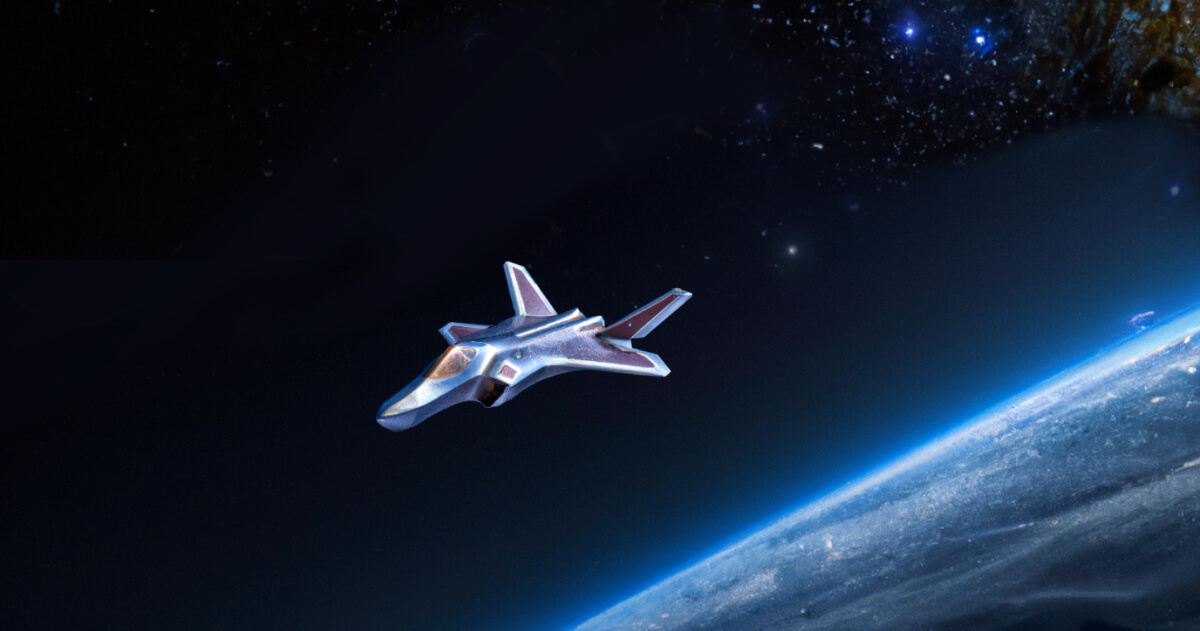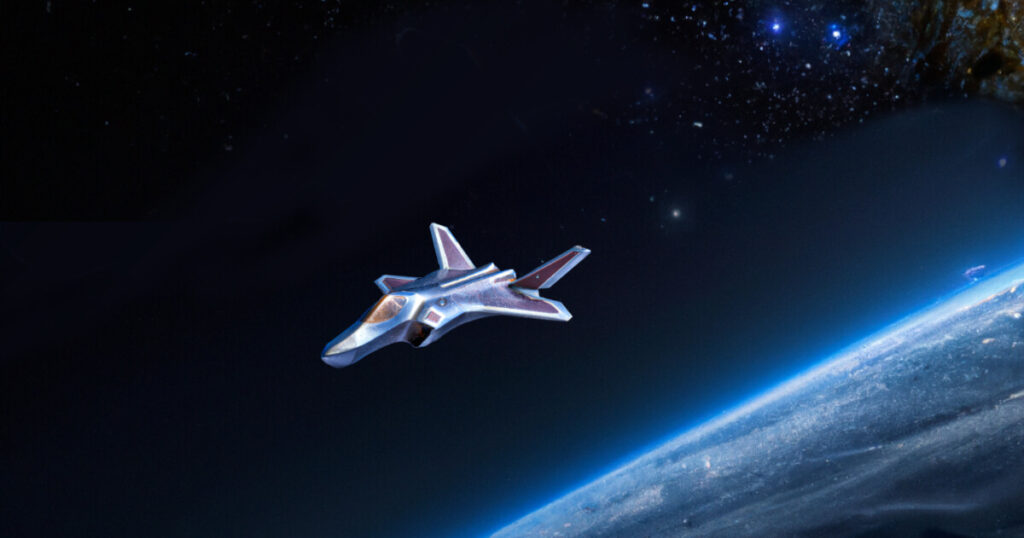
Can Fighter Jets Fly in Space?

As an aviation enthusiast, you have probably been asked this question more than once. But as it turns out, when you really get into the details of explaining the difference between flying in the atmosphere and flying in space, the answer is a lot more interesting than just a simple, “no, not really.”
Two major reasons why fighter jets, or any aircraft, cannot fly in space are: (1) jet fighters need air to burn fuel for generating the thrust that carries them forward, and (2) they need the air in the atmosphere to create the lift required for flight, which is absent in the vacuum of space.
(Brief tangent: If you’re one of those people who is bothered by the order of words in the phrase “fighter jet” or “jet fighter”, rest assured that we’ve used both throughout this post, just to accommodate your preference, whichever that is. ;) )
In this article, we break down all of the interesting questions around flight in space versus regular flight, and the factors that make the two very, very different.
A Question of Thrust: Fighter Jets vs. Spacecraft
In a recent conversation, a bright young school student asked me, “If wings use the air in the atmosphere to create lift — and there’s no air in space — why does the space shuttle have wings?”
It’s a pointed question, and again, there’s more to it than just that the space shuttle needs wings to fly back to earth after it re-enters the atmosphere. After all, if other space vehicles like the CM-107 didn’t need wings, why does the space shuttle?
We’ll get to that later, but for now, let’s stay with aircraft.
Conventional aircraft need both thrust and lift for sustained flight; thrust from the engine to propel the aircraft (and to keep generating lift) and lift from the wings to keep the aircraft aloft.
But the higher you go, the thinner the air becomes. ‘Thinner’ air just means that the molecules of air are less closely packed together, meaning that at higher altitudes, air exerts ever lesser force (pressure) on flying objects. This translates to greatly reduced lift, to the point where, at extremely high altitudes, an aircraft can no longer rely on lift to gain altitude.
At that point, thrust is the only force available to counter the aircraft’s weight and climb further.
A case in point is the X-15, a hypersonic, rocket-powered, crewed aircraft extensively tested by NASA and the USAF between 1959 and 1968. The X-15 designers knew that it would be flying at extremely high altitudes where lift would no longer aid flying.
So, instead of designing it like most other military jets, the X-15 engineers built it with barely any wings to speak of (the X-15’s wing area is just 200 square feet, compared to, say, the F-15’s wing area of 608 square feet). Instead, they equipped it with a bunch of specially-designed, “thruster” rockets that gave the X-15 a thrust-to-weight ratio of a whopping 2.0.
As a quick refresher of a highschool physics textbook might tell us, thrust-to-weight ratio is just the value of the total thrust a vehicle can produce, divided by its weight.
By way of contrast, the F135 engine used on the F-35 is capable of generating a maximum thrust of 191 kilonewtons (abbreviated ‘kN’), that’s 43,000 lbf (‘lbf’ stands for ‘pound force’). Even with just half its fuel capacity, the F-35 weighs in at 38,300 lb, giving it a thrust-to-weight ratio of just about 1.12.
Space-going vehicles, on the other hand, tend to have much higher thrust-to-weight ratios, especially by the time they’re actually at altitudes high enough to be considered “space”. For instance, even with its rocket engines jettisoned, the space shuttle’s main engines still produced 470,000 lbf of thrust, giving it a thrust-to-weight ratio of 2.0!
For reference, the table below shows the thrust-to-weight ratio of a few other aircraft below. (Bear in mind that thrust-to-weight ratio changes over time; as a vehicle burns more fuel and becomes lighter, its thrust-to-weight ratio increases.)
| Aircraft | Thrust-to-Weight Ratio |
|---|---|
| Su-35S | 1.30 |
| F-15 | 1.29 |
| Su-27 | 1.26 |
| Eurofighter | 1.25 |
| Mig-35 | 1.24 |
| Su-27 | 1.23 |
| Mig-29 | 1.19 |
| F-15 | 1.19 |
| F-22 | 1.18 |
| Su-30 | 1.16 |
| Rafale | 1.16 |
| F-35 | 1.16 |
| Mig-29 | 1.15 |
| F-18 | 1.11 |
| F-16 | 1.09 |
| F-18 | 1.09 |
| F-14 | 1.08 |
| Su-34 | 0.99 |
| Gripen NG | 0.94 |
| Mirage 2000-5 | 0.93 |
| Mirage-2000 | 0.88 |
The X-15’s thrust-to-weight ratio helped it set an altitude record for flying 67 miles (354,200 ft) above the earth’s surface in August, 1963.
In comparison with the X-15, the highest altitude ever achieved by a fixed-wing military aircraft flying under its own power is a modest 23.4 miles (123,523 ft). This record, set by the Russian MiG-25 in August 1977, remains unbroken to this day. (Even the legendary Lockheed U-2’s ceiling of 80,000 ft or 15 miles, doesn’t come close.)
All of which brings us to the question: exactly how high do you have to go before you can say you’ve been to space?
Beyond Kármán: Exiting Earth’s Atmosphere
In order to enter space, an aircraft has to exit the earth’s atmosphere. Contrary to what many people believe, there is no clear boundary at which the atmosphere ends, and space begins. One of the most widely accepted demarcators is the Kármán line, an imaginary boundary separating earth’s atmosphere from so-called ‘outer space’, at an altitude of about 62 miles, or 100 kilometers above the earth’s surface.
To date, the only military aircraft to have crossed the Kármán line is the aforementioned X-15, which reached an altitude about 5 miles higher than the Kármán line. So, technically, the X-15 did fly in space for a total of about 10 minutes!
But when asking whether a jet fighter can fly in space, people are typically thinking of a super-powerful military aircraft that can take off from the ground and fly all the way up to space under its own power. The fact? The X-15 could not do that (nor was it a fighter aircraft).
Instead, the X-15 was actually ‘drop-launched’, which is to say that it was carried up in a mothership (the B-52) to an altitude of about 8.5 miles (45,000 ft). From there, it used its own engine, burning roughly 14,500 lbs of fuel in about 85 seconds to make the steep climb up beyond the Kármán line.
Re-entry: ‘Hot’ Topic or Drag?
As we’ve all seen from countless Hollywood movies, one of the biggest challenges that a spacecraft re-entering the earth’s atmosphere has is to withstand the tremendous heat generated by the friction of air rubbing against the moving craft.
In the case of the X-15, its engineers tackled this challenge by using a special, heat-resistant, extreme-strength nickel alloy in its construction. Called Inconel X, this could withstand the extreme temperatures of up to 1200 °F (650 °C) while the aircraft reentered the atmosphere.
(Reminder: The tragic death of seven astronauts aboard the Space Shuttle Columbia in February 2003, was caused by damage to the shuttle’s heat shield, which caused the heat generated during re-entry to damage the wing, ultimately tearing the shuttle apart.)
Since the days of the X-15, however, spacecraft have adopted something called a ‘blunt-body design’, in which a large, bluntly shaped heat shield encases the smaller, main crew cabin of the craft (or a payload bay in robotic vehicles).
A blunt-body design accomplishes two things:
- It increases ‘drag’, that is, the force exerted by air on a flying object in the direction opposite the object’s flight path. By doing so, a blunt-body design slows down the ‘fall’ of a re-entering spacecraft.
- It allows the large, bluntly shaped heat shield to bear the brunt of re-entry heating, thus protecting the precious crew and cargo.
Now, while a blunt-body design is great for increasing drag and slowing down a re-entering spacecraft, it’s not so great for conventional flight. As the introduction stated, fighter jets, as well as other aircraft are designed to maximize lift and minimize drag.
Simply put, drag is the enemy of speed. The streamlined design that gives most fighter jets their huge advantage when it comes to speed, would simply cause them to fry if they tried to re-enter the earth’s atmosphere from space!
And there you have it – a simple, yet convincing explanation for why a fighter jet could not possibly fly out into space and return safely to earth.
From now on, every time someone asks you the old question about fighter jets flying in space, you know what to do… just forward this article to them!
